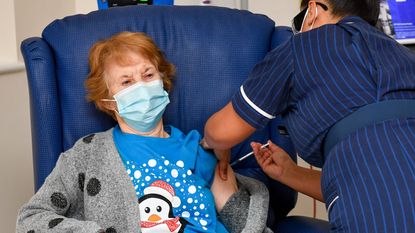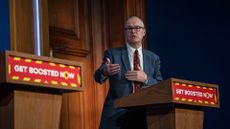How many people need to be vaccinated to get back to normal?
Herd immunity percentage is not a ‘magic threshold’

The UK has taken another tentative step out of lockdown, with the return of indoor socialising at home and in pubs and restaurants.
The blanket travel ban has been lifted, and theatres, sports stadiums and cinemas can reopen, in what has been billed as the penultimate stage before all restrictions are removed on 21 June.
However, the prime minister has warned that the race between the virus and the country’s vaccination rollout could become “a great deal tighter” with the emergence of the Indian Covid-19 variant.
Subscribe to The Week
Escape your echo chamber. Get the facts behind the news, plus analysis from multiple perspectives.

Sign up for The Week's Free Newsletters
From our morning news briefing to a weekly Good News Newsletter, get the best of The Week delivered directly to your inbox.
From our morning news briefing to a weekly Good News Newsletter, get the best of The Week delivered directly to your inbox.
How many vaccines so far?
The UK administered 56.7 million jabs up to 16 May, according to the gov.uk website. First doses have been given to 36.6 million people, while 20.1 million have also had a second shot.
Oxford University researchers calculate that this amounts to nearly 30% of people in the country having full protection, while nearly 54% have partial protection, the highest national proportion in the world apart from Israel.
How many people need the jab?
Sign up for Today's Best Articles in your inbox
A free daily email with the biggest news stories of the day – and the best features from TheWeek.com
Johnson’s roadmap for ending the UK’s third lockdown is contingent on the vaccine rollout continuing at pace. Ahead of each step in the lockdown-easing plan, ministers have been weighing up the vaccine rate and its effectiveness in reducing hospitalisations and deaths, against the risks of infection rates and new variants.
The government has said all adults, which make up about 80% of the population, will be offered a vaccination by the end of July. However, not all adults are able or willing to have the shot.
“To go back to a pre-pandemic lifestyle, we would need at least 70% of the population to be immune to keep the rate of infection down (‘achieve herd immunity’) without restrictions on activities,” say Gypsyamber D’Souza and David Dowdy, epidemiologists at Johns Hopkins Bloomberg School of Public Health.
But they say that the herd immunity percentage is not a “magic threshold”, as both viral evolution and changes in human interaction can affect the number.
With an “amazingly successful” vaccination drive, and cases, hospitalisations and deaths down, there is a “window of opportunity to eliminate the virus in the UK, or at least to bring it to near extinction, and to concentrate on controlling isolated outbreaks”, says Adam Kleczkowski, professor of mathematics and statistics at the University of Strathclyde, writing for The Conversation.
However, he notes that the herd immunity threshold for new variants is “probably higher” than 70% and that, as vaccinations are not 100% effective, a higher proportion of the country will need to be treated. If unvaccinated people are concentrated in the same area, there is also a risk of pockets becoming “a breeding ground for super-spreading events”, says Kleczkowski.
“Globally, extremely uneven vaccination rates pose another hurdle to herd immunity,” writes Joshua Cohen in Forbes. As each successive wave proves, “the virus is highly transmissible and frequently generates new variants of concern”, says Cohen, and this has “important implications for public health policy in countries that are presently ahead in the vaccination race”.
Create an account with the same email registered to your subscription to unlock access.
-
 Major League Baseball is facing an epidemic of pitcher's injuries
Major League Baseball is facing an epidemic of pitcher's injuriesUnder the Radar Many insiders are blaming the pitch clock for the rise in injuries — but the league is not so sure
By Justin Klawans, The Week US Published
-
 8 movie musicals that prove the screen can share the stage
8 movie musicals that prove the screen can share the stageThe Week Recommends The singing and dancing, bigger than life itself
By Scott Hocker, The Week US Published
-
2024 Mother's Day Gift Guide
The Week Recommends A present for every mom
By Catherine Garcia, The Week US Published
-
 Covid four years on: have we got over the pandemic?
Covid four years on: have we got over the pandemic?Today's Big Question Brits suffering from both lockdown nostalgia and collective trauma that refuses to go away
By Chas Newkey-Burden, The Week UK Published
-
 The hollow classroom
The hollow classroomOpinion Remote school let kids down. It will take much more than extra tutoring for kids to recover.
By Mark Gimein Published
-
 Excess screen time is making children only see what is in front of them
Excess screen time is making children only see what is in front of themUnder the radar The future is looking blurry. And very nearsighted.
By Devika Rao, The Week US Published
-
 Covid-19: what to know about UK's new Juno and Pirola variants
Covid-19: what to know about UK's new Juno and Pirola variantsin depth Rapidly spreading new JN.1 strain is 'yet another reminder that the pandemic is far from over'
By Arion McNicoll, The Week UK Published
-
 Long-term respiratory illness is here to stay
Long-term respiratory illness is here to stayThe Explainer Covid is not the only disease with a long version
By Devika Rao, The Week US Published
-
 Covid inquiry: the most important questions for Boris Johnson
Covid inquiry: the most important questions for Boris JohnsonTalking Point Former PM has faced weeks of heavy criticism from former colleagues at the public hearing
By The Week Staff Published
-
 China's pneumonia cases: should we be worried?
China's pneumonia cases: should we be worried?The Explainer Experts warn against pushing 'pandemic panic button' following outbreak of respiratory illness
By Keumars Afifi-Sabet, The Week UK Published
-
 Vallance diaries: Boris Johnson 'bamboozled' by Covid science
Vallance diaries: Boris Johnson 'bamboozled' by Covid scienceSpeed Read Then PM struggled to get his head around key terms and stats, chief scientific advisor claims
By The Week UK Published